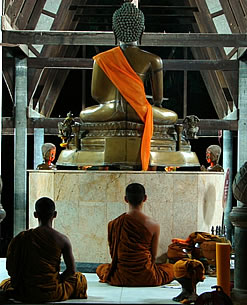Temple Tale
Wat Kao Sab, Rayong, Thailand

The color catches your eye. Through the crowds, up ahead, a golden orange plays between the people. Head shaved, sandal clad and carrying a bag which is coordinated with his robe, he steps clear of women and moves calmly and easily as he works his way through the crowd. Seeing the ubiquitous monks while traveling in Thailand becomes commonplace only a few days after stepping from the plane.
In a country where towns sometimes bankrupt themselves to built extravagant temples, Buddhism is a part of daily life. Taking bowl and robe is a presumption for every Thai male. Most spend only three months as 'men of the robe,' in keeping with Thai tradition, or when an elder in the family dies.
But in a tiny Wat (temple) south of Bangkok, along a stretch of beach where aborted developments rise starkly white along a lazy shoreline, boys as young as ten have taken on the weight of the monks' life, something common throughout Thailand.
In spite of the strict rules of Buddhist life, the temple is the only option for many of these boys. Gambling, drinking, gangs and poverty push them out of their homes and into the temples where they are guaranteed education, shelter and relative safety. Here they spend their adolescent years, replacing football and video games with meditation, study and a dutiful life.
On a second visit to Thailand, I returned to a temple where I had previously lived and studied. The leader of the temple, called Phra Ajarn, which literally translates as “excellent teacher”, welcomed me and my friend and invited us to participate in the daily life of the temple while we stayed. It was a privilege to be allowed to join in meditation and meals with the nearly 400 boys living and studying at Wat Khao Sarb.
The sky was still dark when we woke and dressed and stumbled down the long lane from our teak cabin to the meditation courtyard. Next to the school, in the courtyard, a plastic, thatched mat had been placed on the tiles for us to sit on. Phra Ajarn, the founder and leader of the school, sat on an elevated pedestal just below the imposing Buddha image that presided over the gathered novices. Phra Ajarn’s eyes were closed. One of the boys, a novice named Yut, lead us to our mat and showed us how to cross our legs right over left and place our hands, again right over left, upright in our laps. Backs straight, breathing steadily in through our nose and out through our mouths, Phra Ajarn tells us to 'think nothing.' This was the meditation pose. As the cicadas started their deafening hum, we closed our eyes and tried to ignore our aching feet, the crawling of bugs, and the temptation to watch all of the novices sitting around us. (Watch the video)
I couldn't resist. The boys slumped and nodded. There was always someone there to remind them to sit straight and stay awake. I watched Donlapon, an older novice also known as 'Tae', as he moved through the boys to keep them attentive. The new students were all young. Tae, an advanced novice close to graduation, was gentle and graceful with the young novices. The long rows of boys in their robes, all still and silent in the growing dawn, made me ache for something I couldn't name. After half an hour they all sat up and chanted together, bowing to the Buddha over and over. When they had finished, it was time to go into town and collect food for the day from the townspeople.
We rode in a songteaw, a truck converted into a sort of bus with two rows of seats built into the truck-bed. Once in town, the boys walked in a line down the roadside behind Phra Ajarn, stopping in front of old women who gave them bags of food and spooned rice into their bowls. Without this daily offering, the four hundred boys at the temple would not eat. They ate only twice a day as it was, at 7:30 am and again at 11:30 am. They did not eat after noon. They did not play games or run or sing or dance. They did not listen to music or clap their hands in rhythm. They are supposed to be constantly in a state of calm. All of this is in accordance with Buddhist beliefs.
When they turn eighteen they may disrobe and continue on to University. Many make the transition out of the temple slowly, moving to Bangkok where they stay as borders at other temples in the city until they find jobs and a place to live. It is a rough, strangely joyful changeover from temple life to real life. But until they turn eighteen, they will be here, meditating through the dawn of each day as their adolescent lives are lived out at the temple.
